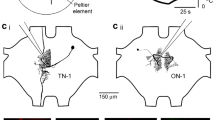Summary
Frequency representation in the auditory brainstem nuclei of the fattailed gerbil (Pachyuromys duprasi) was studied by focal iontophoretic HRP injections into the cochlear nucleus at physiologically characterized positions. Tuning curves of cochlear nucleus neurons were determined by extracellular recording of multi-unit spike activity prior to HRP application. Neurons with characteristic frequencies of 0.55 to 17.5 kHz were recorded. Anterograde labeling of synaptic terminal fields demonstrated a tonotopic arrangement of frequencies within the cochlear nucleus subdivisions and the lateral and medial superior olivary nuclei. In all nuclei investigated terminal fields were arranged in isofrequency planes. In the subdivisions of the cochlear nucleus and in the lateral superior olive the frequency range from 0.55 to 17.5 kHz was represented. In the medial superior olive on the other hand, frequency representation was restricted to frequencies below 3.5 kHz. Quantitative evaluation of tonotopy showed that the frequency representation in the anteroventral and posteroventral cochlear nucleus and lateral superior olive were very similar. The amount of tissue-volume processing one octave varied within the hearing range. The frequency range of highest auditory sensitivity (between 1 and 5 kHz) occupied up to 25% nuclear tissue/octave, while at the upper and lower limits of the hearing range, frequencies were represented by a ratio of 10–15% nuclear tissue/octave. The frequency representation pattern in these brainstem nuclei reflected exactly the frequency place map of the cochlea.
Similar content being viewed by others
References
Adams JC (1977) Technical considerations on the use of horseradish peroxidase as a neuronal marker. Neuroscience 2:142–145
Bourk TR, Mielcarz JB, Norris BE (1981) Tonotopic organization of the anteroventral cochlear nucleus of the cat. Hearing Res 4:215–241
Bruns V (1976) Peripheral tuning for fine frequency analysis by the CF-FM bat Rhinolophus ferrumequinum. I. Frequency mapping of the cochlea. J Comp Physiol 106:87–97
Covey E, Jones DR, Casseday JH (1984) Projections from the superior olivary complex to the cochlear nucleus in the tree shew. J Comp Neurol 226:289–305
Faye-Lund H (1986) Projection from the inferior colliculus to the superior olivary complex in the albino rat. Anat Embryol 175:35–52
Feng AS, Vater M (1985) Functional organization of the cochlear nucleus of roufus horseshoe bats (Rhinolophus rouxi): frequencies are arranged in slabs. J Comp Neurol 235:529–553
Frisina RD, Chamberlain SC, Brachman ML, Smith RL (1982) Anatomy and physiology of the gerbil cochlear nucleus: an improved surgical approach for microelectrode studies. Hearing Res 6:259–275
Glendenning KK, Hutson KA, Nudo RJ, Masterton RB (1985) Acoustic chiasm. II. Anatomical basis of binaurality in lateral superior olive of cat. J Comp Neurol 232:261–285
Guinan JJ, Norris BE, Guinan SS (1972) Single auditory units in the superior olivary complex. II. Location of unit categories and tonotopic organization. Int. J Neurosci 4:147–166
Kössl M, Vater M (1985) The cochlear frequency map of the mustache bat Pteronotus parnellii. J Comp Physiol A 157:687–687
Lay D (1972) The anatomy, physiology, functional significance and evolution of specialized hearing organs of gerbillinae rodents. J Morphol 138:41–120
Liberman MC (1982) The cochlear frequency map for the cat: labeling auditory nerve fibers of known characteristic frequency. J Acoust Soc Am 72:1441–1449
Lindner A, Berchtold W (1982) Statistische Methoden. Birkhäuser Verlag, Basel
Machmert H, Theiss D, Schnitzler H-U (1974) Konstruktion eines Luftschallgebers mit konstantem Frequenzgang im Bereich von 15 bis 130 kHz. Acoustica 34:81–85
Melzer P (1984) The central auditory pathway of the gerbil Psammomys obesus: a deoxyglucose study. Hearing Res 15:187–195
Merzenich MM, Reid MD (1974) Representation of the cochlea within the inferior colliculus of the cat. Brain Res 77:397–415
Merzenich MM, Knight PL, Roth GL (1975) Representation of cochlea within primary auditory cortex in the cat. J Neurophysiol 38:231–249
Mesulam MM (1978) Tetramethylbenzidine for horseradish peroxidase neurohistochemistry: a non-carcinogenic blue reaction product with superior sensitivity for visualizing neural afferents and efferents. J Histochem Cytochem 26:106–117
Nordeen KW, Killackey HP, Kitzes LM (1983) Ascending projections to the inferior colliculus in the adult gerbil, Meriones unguiculatus. J Comp Neurol 214:131–143
Ott H, Müller M, Bruns V (1986) Frequenzabbildung und Innervation der Cochlea von Gerbilliden (Pachyuromys duprasi). Verh tsch Zool Ges 79:288–289
Ostwald J (1984) Tonotopical organization and pure tone response characteristics of single units in the auditory cortex of the greater horseshoe bat. J Comp Physiol A 155:821–834
Plassmann W, Peetz W, Schmidt M (1987) The cochlea in gerbilline rodents. Brain Behav Evol 30:82–101
Pollak GD, Schuller G (1981) Tonotopic organization and encoding features of single units in inferior colliculus of horseshoe bats: functional implications for prey identification. J Neurophysiol 45:208–226
Roullier EM, Cronin-Schreiber R, Fekete DM, Ryugo DK (1986) The central projections of intracellularly labeled fibers in cats: an analysis of terminal morphology. J Comp Neurol 249:261–278
Ryan AF (1976) Hearing sensitivity of the mongolian gerbil, Meriones unguiculatus. J Acoust Soc Am 59:1222–1226
Ryan AF, Woolf NK, Sharp FR (1982) Tonotopic organization in the central auditory pathway of the mongolian gerbil: a 2-deoxyglucose study. J Comp Neurol 207:369–380
Ryan AF, Furlow Z, Woolf NK, Keithly EM (1988) The spatial representation of frequency in the rat dorsal cochlear nucleus and inferior colliculus. Hearing Res 36:181–190
Tsuchitani C, Boudreau JC (1966) Single unit analysis of cat superior olive S-segment with tonal stimuli. J Neurophysiol 29:684–697
Vater M, Feng AS, Betz M (1985) An HRP-study on the frequency place map of the horseshoe bat cochlea: morphological correlates of the sharp tuning to a narrow frequency band. J Comp Physiol A 157:671–686
Zook JM, Winer JA, Pollak GD, Bodenhamer RD (1985) Topology of the central nucleus of the mustache bat's inferior colliculus: correlation of single unit properties and neuronal architecture. J Comp Neurol 231:530–546
Author information
Authors and Affiliations
Rights and permissions
About this article
Cite this article
Müller, M. Quantitative comparison of frequency representation in the auditory brainstem nuclei of the gerbil, Pachyuromys duprasi . Exp Brain Res 81, 140–149 (1990). https://doi.org/10.1007/BF00230110
Received:
Accepted:
Issue Date:
DOI: https://doi.org/10.1007/BF00230110



